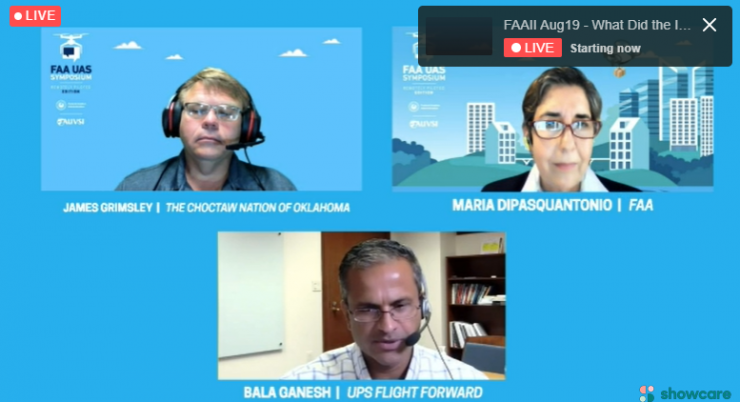By Jenny Beechener
Three developments are necessary before drone operations become economically viable according to Bala Ganesh Vice President Advanced Technology Group, UPS Flight Forward. “The first is beyond visual line of sight (BVLOS); the second is remote operations; and the third is one operator to many drones.” At this point the economic model starts to makes sense and the company begins to see benefits, he said.
Ganesh was speaking at the Federal Aviation Administration (FAA)/AUVSI Unmanned Aircraft Systems (UAS) Symposium which took place online 18-19 August 2020, attended by over 1,500 participants.
Since UPS Flight Forward received the US’ government’s first full Part 135 Standard certification to operate a drone airline, the company has expanded its drone delivery service further to support hospital campuses around the country and to provide solutions for customers beyond those in the healthcare industry.
“Today we are operating by exception,” said Ganesh. “We have to start operating by rule rather than exception. We’ve got to pivot from firsts to getting into normal operations.” He says UPS is climbing this ladder with the FAA in order to make the transition from testing to a business.
The company is one of many operators supported by the FAA’s Office of UAS Integration, and participating in flight trials under the FAA Integration Pilot Program. Launched in 2017, this programme concludes in October 2020.
“The journey is not done,” said Jay Merkle Executive Director of the Office of UAS Integration. “We are in the process of working with the Department of Transportation the White House and Congress on what happens next. We will flow into a new set of agreements that we are currently working on. We already have a Memorandum of Agreement that will form the new version of the IPP and the operations will continue.”
In the next version, operations will be more targeted, and will be very focused on performance-based rules to enable operations, according to Merkle. “BVLOS is the prize we are looking for”.
This was confirmed in a keynote from the US Secretary of Transportation Elaine Chao: “The programme has provided great insight into how to engage local communities and secure their support for innovative drone operations. The information gathered is helping to formulate future policy and rule-making and to enable more complex routine drone operations in the future. The key challenges remain BVLOS and detect-and-avoid solutions.”
According to FAA Administrator Steve Dickson the next version of the IPP will focus on “scaling UAS operations more broadly and integrating them in the national airspace”. He concedes the technical issue of BVLOS is one of the biggest issues to tackle. “We want to make those operations routine, we want to scale them, and we want them to be economically viable. That will be a big focus.”
Dickson is leading several new UAS initiatives in support of safe UAS integration and expanding operations. He is confident the FAA will publish its finalised Remote Identification rule by the end of 2020. “We’ve taken 53,000 comments and we are doing what we can to balance all stakeholder interests. We are moving progressively to getting the final rule out in December.”
Dickson also announced a new development in its outreach programme aimed at drone users. “We are addressing the language barrier that prevents FAA from communicating with growing number of people interested in operations by translating content on the FAA website.” Selected pages are expected to become available in Spanish from September 2020. “Communication is key,” added Dickson. “Drone pilots need to know rules of the air and more needs to be done, especially as we try to scale operations.”
In addition, the FAA plans to modernise the way it presents Notices to Airman (NOTAMs). “NOTAMS is an arcane way to disseminate information. We are in the process of making this more accessible.” English is the language of aviation, but this is used in a different context by manned aviation where voice permeates almost all activity. “We have a lot of work to do in community engagement,” he added. “We need to make sure public is engaged with issues such as public safety and noise.” These issues will be included amongst next IPP activities.
Dickson said the Low Altitude Authorization and Notification Capability (LAANC) programme features 17 approved service providers who issue automated approvals for drone operations relating to 600 airports. “In September, the FAA will add another 130 airports to the list and is due to launch another application process in Spring 2021 to expand the list of authorised service providers.”
Meanwhile among other initiatives, the FAA is addressing data security provisions and responding to recommendations made by the Drone Advisory Committee earlier this year to refine UAS facility map grids. “We want to continue the crawl, walk, run approach and getting Remote Identification is next phase of that,” added Dickson.
For more information visit:




